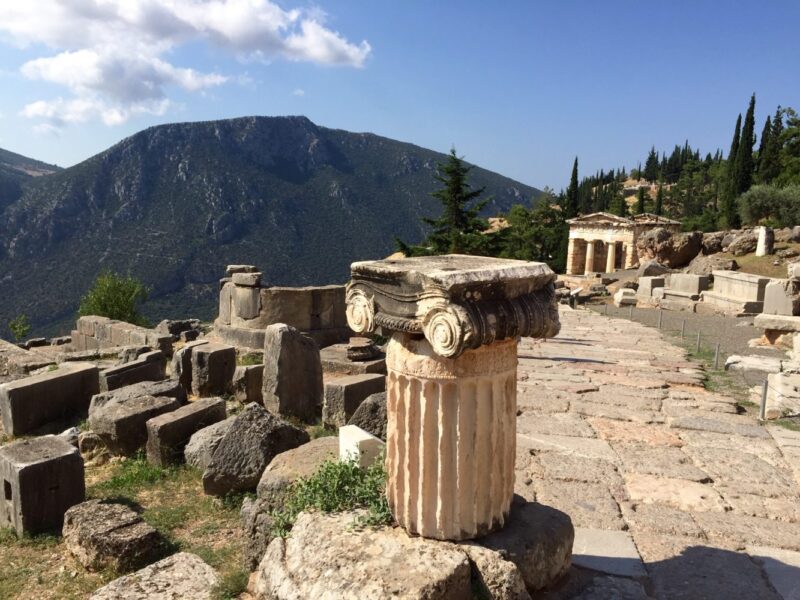If you stroll through the Monastiraki district or the narrow streets of Plaka, you’re sure to pass the Roman agora, also known as the Roman Forum of Athens (not to be confused with the nearby ancient agora).
A large quadrilateral measuring 111 metres long by 98 metres wide, the Roman agora was used to house the city’s commercial activities when the ancient agora proved too small for trade. It was built in the 1st century BC.
The site is entered through the imposing Gate of Athena Archegetis, a large structure composed of four columns that looks like a temple façade and stands on the western edge of the archaeological site. This door is well preserved.
Like the ancient Agora, in Roman times, the entire site was covered with houses and shops. Today, it takes a little (not to say a lot) of imagination to picture it.
Tower of the winds
The most famous building in the Roman agora is undoubtedly the Tower of the winds. This eight-sided marble tower was built in the 1st century BC by the astronomer Andronikos. It combined a water clock, a sundial and a weather vane (once shaped like a Triton and placed at the top, it has unfortunately long since disappeared).
The top of the tower is adorned with a frieze representing the eight directions of the wind, symbolized by winged figures. Look closely, and you’ll see, for example, that the northeast wind is represented by a bearded man holding a shield filled with hailstones, while the gentle wind is symbolized by a cherub scattering flowers from his cloak in the air.
The building has recently been renovated and looks stunning. However, you can still admire it from the outside, especially from Aiolou street. The interior is of little interest (a few traces of paint remain, but they’re so faded that they’re hard to see).

Fethiye Djami Mosque, one of Athens’ few Ottoman relics
The Fethiye Djami mosque is located on the north side of the Roman agora. It was built on the ruins of an early Christian basilica, converted into a mosque in 1458 to celebrate the visit of Sultan Mehmet the Conqueror to Athens. During the Venetian occupation, the mosque was converted into a Catholic church. Then, after the War of Independence in 1821, it was used as a school for an organization of intellectuals. More recently, the mosque has been used to store antiquities found on the Agora site.
The Fethiye mosque had been closed to the public since 1963. It reopened to the public in August 2017 after undergoing a complete renovation. The interior is extremely sober, even bare. Also, the mosque hosts temporary exhibitions from time to time.

Roman Agora in practice
Where is the Roman Agora?
The Roman Agora or Forum is easily accessible from Monastiraki Square, metro lines 3 (blue) and 1 (green). Then head up towards the Plaka district, and you should find the agora. Located at Polignotou 3 in Athens (Google Maps), the Roman Agora has the advantage of being visible from the outside. And you can even walk around it.
Note that the site is partially accessible to people with disabilities and reduced mobility (Roman Agora accessibility map for PRM – Source The heart of Ancient Athens.gr).
Opening hours
The Roman Agora is open every day. In summer, from 8am to 8pm; in winter, from 8am to 3pm. Opening times are subject to change, particularly in September and October, when the site closes at dusk. You can check opening times on the official website.
Please note that the site is closed on January 1, March 25, May 1, Easter Sunday, December 25 and 26.
Prices for visiting the Agora and the Tower of the Winds
- Full rate 10€
- Reduced rate 5€ for EU citizens over 65 between October 1 and May 31
- Free admission for EU citizens under 25, non-EU citizens under 18, EU students, persons with disabilities and one escort (only in the case of 67% disability)… On presentation of ID and other supporting documents.
The Roman Agora is free for everyone on March 6, April 18, May 18, the last weekend in September, October 28 and the 1st and 3rd Sunday of every month from November 1 to March 31.
You’ll find all the information you need on the official website.
In practice, tickets can be purchased:
- on site, outside the archaeological site. In the yellow building at number 6, Epaminonda street.
- online, on Get Your Guide with audioguide in English (be sure to select the audioguide for the site and not the one for the city of Athens), or Hellenic Heritage.
If you don’t have a lot of time and/or a small budget, it’s worth noting that the site is clearly visible through the grids. The interior is hardly more impressive. From the outside, you can admire the Roman agora, the Tower of the Winds and the Fethiye Djami mosque. This gives you an idea of the sheer size of the site and its rich past.
Finally, if you visit the site in summer, be aware that it’s very hot and there’s no shade. So don’t forget a hat and sun cream. And don’t forget your water.
Or this combined Greek Agora + Roman Agora ticket. All tickets are non-refundable.
Contact : Tel +30 210 3245 220 / Email : efaath@culture.gr / Website Odysseus culture
Laure M.




